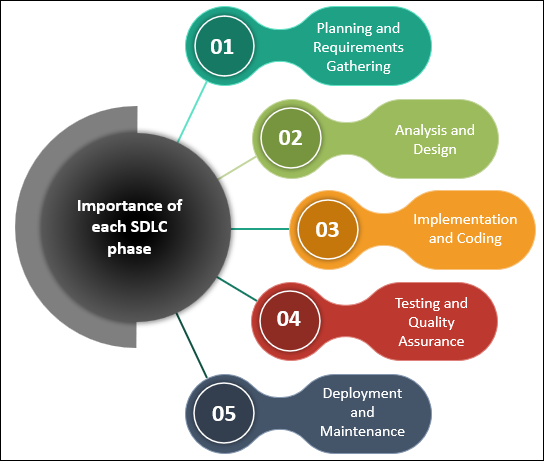SDLC Phases
Introduction :
The Software Development Life Cycle (SDLC) consists of several phases that outline the process of developing software. The exact number and names of the phases may vary depending on the methodology or framework being followed. However, the following are commonly recognized phases of the SDLC:
- Requirements Gathering and Analysis: In this phase, the software requirements are collected from stakeholders, analyzed, and documented. It involves understanding the problem to be solved, identifying user needs, and defining functional and non-functional requirements.
- System Design: In this phase, the system architecture and design are created based on the requirements gathered in the previous phase. The design includes decisions on the overall structure of the system, database design, user interface design, and software component specifications.
- Implementation and Coding: This phase involves the actual development of the software. The design is translated into code using programming languages and development tools. Developers follow coding standards and best practices to ensure the quality and maintainability of the code.
- Testing: Testing is a crucial phase to verify that the software meets the specified requirements and works as intended. It includes different types of testing, such as unit testing, integration testing, system testing, and user acceptance testing. Bugs and issues are identified, reported, and fixed during this phase.
- Deployment: Once the software has passed testing and quality assurance, it is deployed to the production environment. This involves preparing the infrastructure, installing the software, configuring settings, and ensuring the software is ready for end-users.
- Maintenance: After deployment, the software enters the maintenance phase. It involves monitoring the performance of the software, addressing any issues or bugs reported by users, and making necessary updates or enhancements to improve the software's functionality or address changing needs.
Some methodologies, such as Agile or DevOps, follow iterative or continuous development cycles, where the phases overlap or are executed in shorter iterations. These methodologies emphasize flexibility, collaboration, and continuous improvement throughout the SDLC.
It's important to note that the SDLC is a general framework, and specific organizations or projects may adapt or modify the phases to suit their needs and processes. The goal of the SDLC is to ensure a systematic and structured approach to software development, promoting quality, efficiency, and successful software outcomes.
Importance Of Each SDLC Phase:
Each phase of the Software Development Life Cycle (SDLC) serves a crucial purpose and contributes to the successful development of software applications. Here's the importance of each SDLC phase:
- Planning and Requirements Gathering: This phase sets the foundation for the entire project. It ensures that the project objectives and requirements are clearly defined and understood. Proper planning helps in estimating resources, timelines, and risks, setting realistic expectations, and aligning stakeholders' interests.
- Analysis and Design: This phase focuses on translating the requirements into a detailed design plan. It ensures that the software solution is architecturally sound, scalable, and aligned with business goals. Effective analysis and design reduce rework, improve development efficiency, and facilitate a smooth implementation phase.
- Implementation and Coding: This phase involves the actual development of the software solution. Skilled developers write code, integrate components, and follow coding best practices. Proper implementation ensures that the software functions as intended and adheres to the design specifications.
- Testing and Quality Assurance: Testing is critical to ensure that the software meets quality standards and user expectations. Different types of testing are conducted to identify and resolve bugs, errors, and functional issues. Quality assurance activities validate the software against requirements and verify its overall performance and reliability.
- Deployment and Maintenance: Deployment ensures the software is successfully released to the production environment. Proper installation, configuration, and data migration are essential for a smooth transition. The maintenance phase focuses on ongoing support, bug fixes, updates, and enhancements to meet evolving user needs and address any issues that arise.
Each SDLC phase contributes to overall project success by providing structure, control, and quality assurance throughout the development process. By following the phases, organizations can reduce risks, improve efficiency, and deliver high-quality software solutions.
Agile Methodology vs. Waterfall Methodology:
Agile Methodology:
- Agile is an iterative and incremental approach that emphasizes flexibility, collaboration, and adaptability.
- It breaks the project into small iterations called sprints, allowing for frequent feedback and continuous improvement.
- Agile welcomes change and promotes customer collaboration throughout the development process.
- It encourages self-organizing teams and relies on regular communication and short feedback loops.
- Agile methodologies include Scrum, Kanban, and Extreme Programming (XP).
- Waterfall is a linear and sequential approach where each phase is completed before moving to the next.
- It follows a fixed plan and scope, with minimal changes during development.
- Waterfall focuses on detailed upfront planning and documentation.
- It works well for projects with stable and well-defined requirements.
- Waterfall is less adaptable to changes during development.
- The SDLC provides a structured framework for software development, ensuring a systematic approach and improved project management.
- Each phase of the SDLC has its importance, contributing to the successful completion of a software project.
- Agile methodology emphasizes flexibility, adaptability, and collaboration, while Waterfall methodology follows a sequential and fixed approach.
- The choice between Agile and Waterfall depends on project characteristics, requirements, and organizational preferences.
- Organizations should choose an SDLC approach that best suits their specific project needs, team dynamics, and customer requirements.
Conclusion:
The Software Development Life Cycle (SDLC) plays a crucial role in ensuring successful software development projects. By following a structured approach, organizations can plan effectively, gather requirements accurately, design robust solutions, implement them efficiently, test thoroughly, deploy smoothly, and maintain the software effectively.
Choosing between Agile and Waterfall methodologies depends on factors like project complexity, requirements volatility, customer involvement, and organizational culture. Each approach has its strengths and weaknesses, and organizations should select the most appropriate SDLC methodology based on their unique circumstances.




